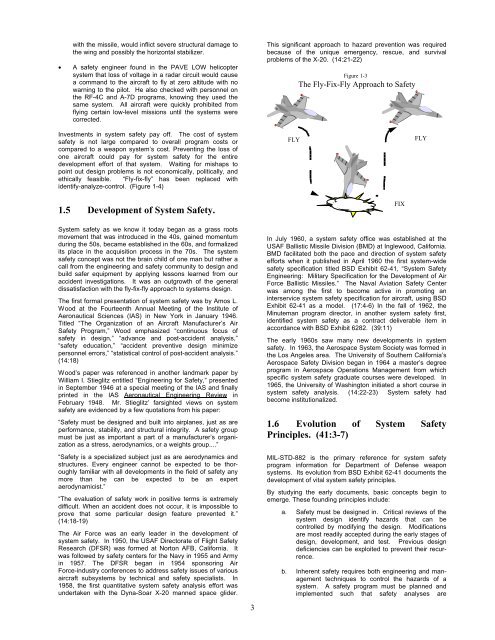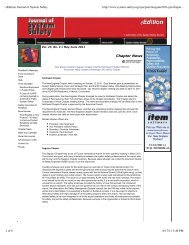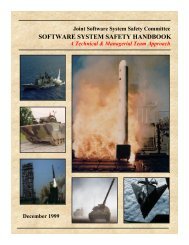Air Force System Safety Handbook - System Safety Society
Air Force System Safety Handbook - System Safety Society
Air Force System Safety Handbook - System Safety Society
You also want an ePaper? Increase the reach of your titles
YUMPU automatically turns print PDFs into web optimized ePapers that Google loves.
with the missile, would inflict severe structural damage to<br />
the wing and possibly the horizontal stabilizer.<br />
• A safety engineer found in the PAVE LOW helicopter<br />
system that loss of voltage in a radar circuit would cause<br />
a command to the aircraft to fly at zero altitude with no<br />
warning to the pilot. He also checked with personnel on<br />
the RF-4C and A-7D programs, knowing they used the<br />
same system. All aircraft were quickly prohibited from<br />
flying certain low-level missions until the systems were<br />
corrected.<br />
Investments in system safety pay off. The cost of system<br />
safety is not large compared to overall program costs or<br />
compared to a weapon system’s cost. Preventing the loss of<br />
one aircraft could pay for system safety for the entire<br />
development effort of that system. Waiting for mishaps to<br />
point out design problems is not economically, politically, and<br />
ethically feasible. “Fly-fix-fly” has been replaced with<br />
identify-analyze-control. (Figure 1-4)<br />
1.5 Development of <strong>System</strong> <strong>Safety</strong>.<br />
<strong>System</strong> safety as we know it today began as a grass roots<br />
movement that was introduced in the 40s, gained momentum<br />
during the 50s, became established in the 60s, and formalized<br />
its place in the acquisition process in the 70s. The system<br />
safety concept was not the brain child of one man but rather a<br />
call from the engineering and safety community to design and<br />
build safer equipment by applying lessons learned from our<br />
accident investigations. It was an outgrowth of the general<br />
dissatisfaction with the fly-fix-fly approach to systems design.<br />
The first formal presentation of system safety was by Amos L.<br />
Wood at the Fourteenth Annual Meeting of the Institute of<br />
Aeronautical Sciences (IAS) in New York in January 1946.<br />
Titled “The Organization of an <strong>Air</strong>craft Manufacturer’s <strong>Air</strong><br />
<strong>Safety</strong> Program,” Wood emphasized “continuous focus of<br />
safety in design,” “advance and post-accident analysis,”<br />
“safety education,” “accident preventive design minimize<br />
personnel errors,” “statistical control of post-accident analysis.”<br />
(14:18)<br />
Wood’s paper was referenced in another landmark paper by<br />
William I. Stieglitz entitled “Engineering for <strong>Safety</strong>,” presented<br />
in September 1946 at a special meeting of the IAS and finally<br />
printed in the IAS Aeronautical Engineering Review in<br />
February 1948. Mr. Stieglitz’ farsighted views on system<br />
safety are evidenced by a few quotations from his paper:<br />
“<strong>Safety</strong> must be designed and built into airplanes, just as are<br />
performance, stability, and structural integrity. A safety group<br />
must be just as important a part of a manufacturer’s organization<br />
as a stress, aerodynamics, or a weights group....”<br />
“<strong>Safety</strong> is a specialized subject just as are aerodynamics and<br />
structures. Every engineer cannot be expected to be thoroughly<br />
familiar with all developments in the field of safety any<br />
more than he can be expected to be an expert<br />
aerodynamicist.”<br />
“The evaluation of safety work in positive terms is extremely<br />
difficult. When an accident does not occur, it is impossible to<br />
prove that some particular design feature prevented it.”<br />
(14:18-19)<br />
The <strong>Air</strong> <strong>Force</strong> was an early leader in the development of<br />
system safety. In 1950, the USAF Directorate of Flight <strong>Safety</strong><br />
Research (DFSR) was formed at Norton AFB, California. It<br />
was followed by safety centers for the Navy in 1955 and Army<br />
in 1957. The DFSR began in 1954 sponsoring <strong>Air</strong><br />
<strong>Force</strong>-industry conferences to address safety issues of various<br />
aircraft subsystems by technical and safety specialists. In<br />
1958, the first quantitative system safety analysis effort was<br />
undertaken with the Dyna-Soar X-20 manned space glider.<br />
3<br />
This significant approach to hazard prevention was required<br />
because of the unique emergency, rescue, and survival<br />
problems of the X-20. (14:21-22)<br />
FLY<br />
Figure 1-3<br />
The Fly-Fix-Fly Approach to <strong>Safety</strong><br />
FIX<br />
FLY<br />
In July 1960, a system safety office was established at the<br />
USAF Ballistic Missile Division (BMD) at Inglewood, California.<br />
BMD facilitated both the pace and direction of system safety<br />
efforts when it published in April 1960 the first system-wide<br />
safety specification titled BSD Exhibit 62-41, “<strong>System</strong> <strong>Safety</strong><br />
Engineering: Military Specification for the Development of <strong>Air</strong><br />
<strong>Force</strong> Ballistic Missiles.” The Naval Aviation <strong>Safety</strong> Center<br />
was among the first to become active in promoting an<br />
interservice system safety specification for aircraft, using BSD<br />
Exhibit 62-41 as a model. (17:4-6) In the fall of 1962, the<br />
Minuteman program director, in another system safety first,<br />
identified system safety as a contract deliverable item in<br />
accordance with BSD Exhibit 6282. (39:11)<br />
The early 1960s saw many new developments in system<br />
safety. In 1963, the Aerospace <strong>System</strong> <strong>Society</strong> was formed in<br />
the Los Angeles area. The University of Southern California’s<br />
Aerospace <strong>Safety</strong> Division began in 1964 a master’s degree<br />
program in Aerospace Operations Management from which<br />
specific system safety graduate courses were developed. In<br />
1965, the University of Washington initiated a short course in<br />
system safety analysis. (14:22-23) <strong>System</strong> safety had<br />
become institutionalized.<br />
1.6 Evolution of <strong>System</strong> <strong>Safety</strong><br />
Principles. (41:3-7)<br />
MIL-STD-882 is the primary reference for system safety<br />
program information for Department of Defense weapon<br />
systems. Its evolution from BSD Exhibit 62-41 documents the<br />
development of vital system safety principles.<br />
By studying the early documents, basic concepts begin to<br />
emerge. These founding principles include:<br />
a. <strong>Safety</strong> must be designed in. Critical reviews of the<br />
system design identify hazards that can be<br />
controlled by modifying the design. Modifications<br />
are most readily accepted during the early stages of<br />
design, development, and test. Previous design<br />
deficiencies can be exploited to prevent their recurrence.<br />
b. Inherent safety requires both engineering and management<br />
techniques to control the hazards of a<br />
system. A safety program must be planned and<br />
implemented such that safety analyses are




